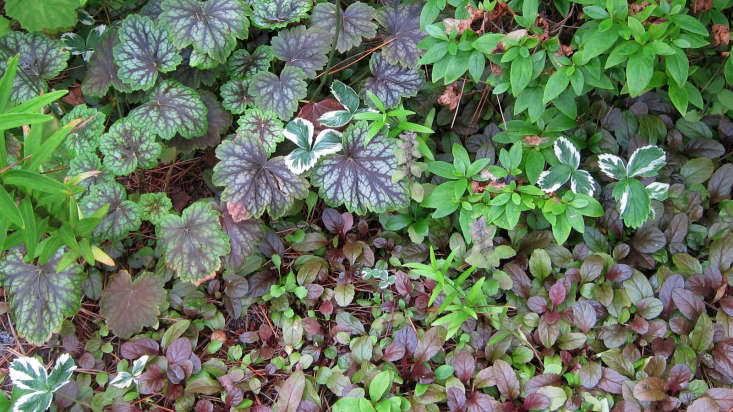Alumroot, Heuchera: “Native Coral Bells”
On a recent birding trip in the Blue Ridge Mountains of North Carolina, my fellow birders and I took a break from looking up for the birds and saw a pretty rosette of fuzzy green foliage beneath our feet.
“That’s alumroot,” our guide said, identifying the short clump of deeply lobed leaves intermingled with the creamy white flowers of native stonecrop (Sedum ternatum) and the purple blooms of the crested dwarf iris (Iris cristata).

Fuzzy-leafed hairy alumroot (Heuchera villosa), which European colonists noticed upon arrival in the 1600s, is one of about 35 to 50 different Heuchera species native to North America and Mexico. These plants have a subdued appearance, compared with hybridized Heucheras widely available today in garden centers in a mind-boggling array of colors from orange to brown to burgundy to chartreuse to purple so dark it looks black.

The natives, including Heuchera americana (American alumroot) and Heuchera richardsonii (Prairie alumroot), are evergreen perennials commonly found in woodlands, prairies, and mountainous areas (although they are adaptable and can be found gamely surviving in crevices of rocky outcroppings and even in deserts).
While they have dainty flowers that grow clustered on gangly upright stalks, Heucheras are most commonly grown for their foliage. The native species may not boast the brilliant colors of the hybrids but their leaves frequently have striking silver and white or purple veining (during winter they sometimes turn shades of purple or bronze). Leaves vary in shape from tiny heart shaped to rounded and ruffled to deeply lobed or cut to those shaped like broad shields as large as salad plates. They are remarkably easy to grow and resist mildew, insects, and larger pests such as deer and rabbits.

Cheat Sheet
- Deadhead faded flower stalks down to the ground to encourage longer bloom time, or remove flower stalks before they bloom to promote a better foliage display.
- Heucheras are happy in partial shade but will tolerate full sun if they are not allowed to dry out (which can cause their leaves to scorch).
- In cold climates, plant shallow-rooted Heuchera in the spring to avoid frost heaving.
- Use Heuchera in the garden along the edges of paths or in the fronts of borders combined with shade tolerant perennials such as hellebores, carex, ferns, hosta, epimedium, and astilbe. They are good plants for containers and when planted in swaths form handsome, evergreen ground covers.
Keep It Alive
- Plant Heuchera in USDA growing zones 3 to 9 in moist, well-drained soil rich in organic matter.
- Divide Heuchera every three or four years (when stems become woody and the plant falls open at the center).
- Gardeners in cold climates should mulch plants for better winter survival.
- Remove any damaged foliage in early spring to make way for colorful fresh leaves.

Before the European colonists arrived, Native Americans recognized the astringent quality of Heuchera and used the roots to treat an amazing array of maladies from skin problems (such as sores, rashes, and wounds) to internal disorders including digestive upsets, infections, and rheumatic pain. There is even evidence of a cosmetic use. The dried root was apparently pounded and made into a poultice to apply to the scalp in the hopes of encouraging hair growth. Little seems to be known about whether this was successful; today we value this lovely plant as an attractive addition to rock gardens and woodland landscapes, grateful that it adds both beauty and life to the garden by attracting butterflies, bees, and even hummingbirds.
N.B.: See more about Heuchera at Gardening 101: Coral Bells. And for more native American wildflowers, see Native Plants: 10 Alternatives to Invasive Garden Invaders.
Finally, get more ideas on how to successfully plant, grow, and care for coral bells with our Coral Bells: A Field Guide.
Finally, get more ideas on how to plant, grow, and care for various perennial plants with our Perennials: A Field Guide.
Additionally, get more ideas on how to plant, grow, and care for various ground cover plants with our Ground Covers: A Field Guide.









Have a Question or Comment About This Post?
Join the conversation